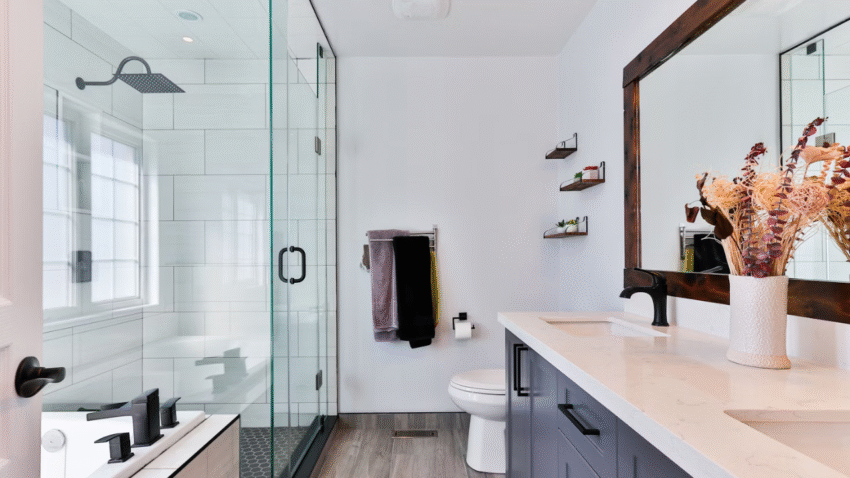Introduction
Dealing with water pooling outside your shower after every use? It’s probably time to learn how to fix a leaking shower door. This common bathroom issue not only makes your floor slippery but also increases the risk of water damage and mold over time. Luckily, there are simple and effective ways to seal things up and prevent future leaks.
In this guide, we’ll walk you through every step to identify the problem, fix it fast, and keep your bathroom floor dry and safe.
Why Fixing a Leaking Shower Door Matters
A leaking shower door might seem like a small nuisance, but it can lead to bigger problems if left unaddressed. Excess water can seep into tiles, grout, or subflooring, causing mold growth, rot, or even structural damage. It also creates a slip hazard, which is especially dangerous in a humid, enclosed space like the bathroom.
By sealing the leak, you’re not just protecting your floors—you’re improving hygiene, preserving the bathroom’s integrity, and even enhancing the look of your shower.
Step-by-Step Guide to Fixing a Leaking Shower Door
1. Identify the Source of the Leak
Before you make any repairs, figure out where the water is escaping. Look for:
- Water on the floor outside the door after a shower
- Drips along the door hinges or base
- Gaps in caulking or cracked seals
- Loose or damaged sweep at the bottom of the door
Use a flashlight and towel to dry the area. Then, run water briefly and observe where the water is getting out.
2. Check and Replace the Door Sweep
The door sweep is the flexible plastic or rubber strip along the bottom of the shower door. Over time, it can warp, crack, or fall off.
To replace it:
- Open the shower door fully and remove the old sweep by sliding it off or unscrewing it (depending on model).
- Measure the length of the door and buy a replacement that matches.
- Trim it to size if needed using scissors or a utility knife.
- Slide or snap the new sweep onto the bottom of the door.
Tip: Choose a clear or matching sweep to maintain a clean appearance.
3. Re-Caulk the Shower Frame
If the frame or corners are leaking, the old caulk may be cracked or missing.
To re-caulk:
- Use a utility knife or caulk remover to scrape away all the old silicone caulk.
- Clean the area with rubbing alcohol or a bathroom-safe cleaner and let it dry completely.
- Apply a bead of waterproof bathroom-grade silicone caulk along the seams of the shower frame, especially where metal meets tile.
- Smooth the bead with a wet finger or caulk tool for a clean finish.
- Let it cure for at least 24 hours before using the shower again.
4. Tighten or Replace Door Seals
Check the vertical seals along the door edges. If they’re loose, cracked, or missing, water can sneak through.
To fix or replace them:
- Peel off or unscrew the old vertical seal (usually magnetic or adhesive-backed).
- Clean the surface with alcohol and dry thoroughly.
- Attach a new vinyl or rubber seal strip—make sure it forms a tight connection between the door and the wall or adjacent panel.
- Test the seal by closing the door and checking for gaps.
5. Adjust the Door Alignment
If the shower door is sagging or misaligned, water may slip out through uneven gaps.
To adjust it:
- Locate the hinges or pivot brackets and use a screwdriver or Allen key to tighten or adjust them.
- Raise or level the door until it sits evenly within the frame and closes snugly.
- Make sure the bottom sweep contacts the threshold evenly across its length.
Warning: Don’t overtighten—this can strip screws or crack glass.
Common Mistakes to Avoid
Mistake 1: Ignoring Old Caulk
Solution: Always remove cracked or peeling caulk. Layering new over old won’t create a watertight seal.
Mistake 2: Using the Wrong Caulk Type
Solution: Only use 100% silicone bathroom caulk, which is mold-resistant and waterproof.
Mistake 3: Not Letting Caulk Cure
Solution: Let fresh caulk dry fully (usually 24 hours) before getting it wet.
Mistake 4: Misaligning the Door Sweep
Solution: Check that the sweep runs level across the threshold and doesn’t have gaps or buckles.
Mistake 5: Overlooking Hidden Leaks
Solution: Water can leak from the wall joint, showerhead arm, or even loose tiles—check thoroughly before assuming the door is the only culprit.
Extra Tips & Bathroom Hacks
- Use a towel or bath mat at the base of the door while testing to detect small leaks.
- Upgrade to frameless shower seals if you’re doing a full bathroom refresh—they’re easier to maintain and look more modern.
- For more ideas, check out our guide on how to seal a shower door properly.
Conclusion
Fixing a leaking shower door isn’t just about stopping a puddle—it’s about protecting your bathroom from long-term damage. From replacing worn sweeps and seals to re-caulking the frame, these steps will keep your shower watertight and your floors dry.
Take your time, follow the instructions carefully, and your bathroom will be back to looking—and functioning—its best in no time.
Bookmark this guide so you can tackle leaks with confidence and keep your bathroom in tip-top shape all year long.
